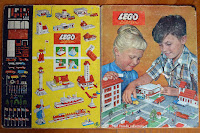The printed cardboard town plan I had when young didn't
survive (I now shudder to remember it was turned into a puppet theatre...) but
did get a replacement much later in life when I found one for a nice price at
the monthly Brussels swap meet. This prompted the acquisition of a few of the
cars and the construction of a few buildings.
A renewed interest has recently resulted in quite a few more
vehicles and buildings being added to an extra couple of shelves in the
bookcase where these are on display. Bringing back the same joy as they did
during the earliest and most carefree days of my life.
I'm no expert, but I gather Lego started making these
vehicles in 1955, initially offering a series of Bedford trucks and VW vans,
the latter strangely without any window openings in the original version. VW
Beetles were added, which were used by VW as promotional toys next to much
larger-sized ones also made by Lego. These were all painted in correct VW
colours, and so stand out amongst all the other vehicles which are moulded in
standard Lego colours (plus green for the VW vans. Baseplates aside, there was
no such thing as a green brick readily available in those days, a few rare
exceptions being produced in Norway apparently).
More car models followed, mostly of German cars but also a few from other countries. Then the Bedfords were replaced with Mercedes trucks with a few types of truck disappearing but more types being added. All in all the range lasted until the second half of the 1960s before disappearing from the Lego catalogue.
My photos show what I have - at least one of each model in
the range, except for the early VW vans, a short version of the VW Beetle
(though I'm restoring one) and a Vauxhall estate. The latter was unique to the
UK and Australian markets, like the Jaguar E-Type which I do have. Bedford
trucks exist in one colour (combination) only; Mercedes trucks exist in several
colours except for the articulated tank trucks. The articulated trailers exist
in one more printed design than I have. The scooters and (motor)cyclists were
also part of the range, as were the traffic signs and flat trees.
Part Two to follow shortly!















I like those. Never knew they existed !
ReplyDeletefabulous aren't they ? I had one of the little Esso Tankers
ReplyDeleteTotally forgotten about these. The only one I recall having was the light grey/white one on the left in then second picture. A Fiat 1800? Didn't realise it was Lego as I get confused with Betta Bilda which I remember having a few small sets of too.
ReplyDeleteHello Yorkie
ReplyDeletethe grey car you mention is a Morris 1100. The one model of a British car that was available everywhere.
Best -- Paul V
Oops no sorry. The white car -at left- in the second picture is a Mercedes 220S.
ReplyDeleteBest -- Paul V
I too never knew that Lego did an HO/00 car series, but they are FAB! They look a lot like the German Viking vehicles of around the same vintage, I wonder if they shared molds at some point? And your sets are too cool for shoes, man!!!
ReplyDeleteThank you!
ReplyDeleteBut no sharing of moulds. These Lego cars are a bit larger than Wiking models.
I have some of those packed away somewhere with the H0 trains of my youth, but can't reach them without a major excavation or I'd do a side-by-side comparison. And with current conditions I can't ask to borrow my neighbour's either unfortunately. :/
Best -- Paul V
Beautiful toys Paul. Like a miniature village! Thanks for sharing.
ReplyDeleteBrilliant little vintage vehicles, Paul. I don't think I've ever seen these myself, so a real treat to see them here, displayed in your Lego cityscape. I particularly like the fleet of VW vans, along with the scooters and bikes. A fantastic collection of early Lego :)
ReplyDeleteThanks Woodsy & Tony.
ReplyDeleteThe setup was quick and temporary to have a bit of background for the cars, which Wotan was curious to see. I need to set it up properly and take some more pics someday.
Bet -- Paul V
These are great models, what a pity Lego no longer still make them. The colours are also very realistic, and not at all garish.
ReplyDeleteThey are indeed lovely little things. But they were introduced at a time that Lego didn't yet make wheels to go with their bricks. After the wheels came in, the basic scale of Lego constructions was greatly increased to fit with the size of those wheels. The little H0-scale cars didn't fit anymore so that was that.
ReplyDeleteTo complete the scale topic - the wheel-based scale lasted for 5 years or so and then the smaller Legoland scale was introduced. More affordable and much more versatile too. Mini-figures were developed to go with that scale and that's what they've continued with ever since.
Best -- Paul